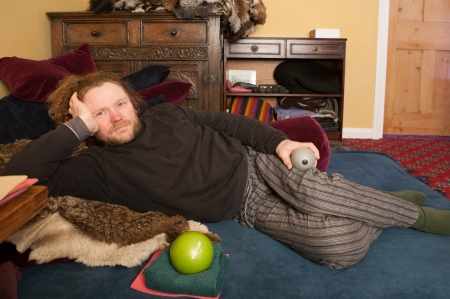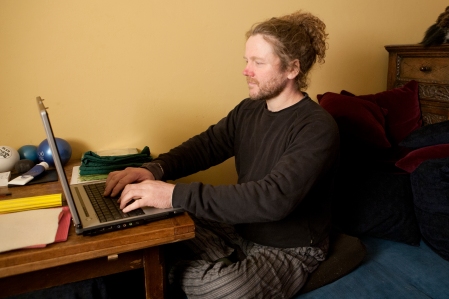
The Comfort of Home
March 17, 2015I went to the cinema a while ago, the first time for a quite a few years. I very much like going to the cinema, and I do like the girl I got to go with, but by the end of the film my lower back was aching, my knees were aching, my feet were numb and I kept getting pins and needles in my left hand. Had I stayed at home and watched a film then I would have been in comfort.
There has always been a ‘comfort of home’ in my life and I believe there is for most people. There is nothing like your own chair or your own bed. Much of it may be due to familiarity rather than physical comfort, a sense of well being gained from sticking with what you know, but when you are seriously disabled there are special needs that must be catered for in different ways.
 I have long since ceased to be a fan of arm chairs and in my twenties, before I even broke my back, I threw mine out and learnt to live a life sitting crossed legged on the floor. The history of the arm chair is interesting, although I have to admit that my knowledge is based on the limited experience of my years and what I have seen in motion pictures and period dramas. The chaise longue seems to go way back into antiquity, but the arm chair is confined to the last few centuries of our civilization and has evolved slowly from the basic concept of a chair, with a wooden seat and upright back, into the ultimate soft furnishing that you can sink into.
I have long since ceased to be a fan of arm chairs and in my twenties, before I even broke my back, I threw mine out and learnt to live a life sitting crossed legged on the floor. The history of the arm chair is interesting, although I have to admit that my knowledge is based on the limited experience of my years and what I have seen in motion pictures and period dramas. The chaise longue seems to go way back into antiquity, but the arm chair is confined to the last few centuries of our civilization and has evolved slowly from the basic concept of a chair, with a wooden seat and upright back, into the ultimate soft furnishing that you can sink into.
The concept of the modern arm chair is not to support your body, but to switch off all muscular activity, leaving your body totally reliant on the quality of your inner capacity, your resistance to compression, for support. This is a concept that works fine for the fit and active whose physical activity during their day is amply sufficient to keep them in good shape and they can well afford to slouch in an arm chair in the evening, but it doesn’t bode well for the more sedentary or disabled. The right to slouch was always the preserve of the working classes who earned it through their hard labour, whereas the aristocracy, who led more sedentary lives, relied on attention to posture to maintain a good stature. These days few people’s working lives keep them fit and the etiquette of the upper classes has long since declined. Combine that with the hours people spend slouched in front of the television or computer and there can be no doubt that health is in trouble.
 As a paraplegic I have never found a comfortable arm chair or couch. Some are very firm and upright, but they take more effort to sit in than a dining room chair and so are difficult for me to relax in. Most you sink into and they only serve to compress my core strength (intrinsic capacity), which is still a little weak. My waist collapses and my chest sinks in and my pelvis folds in on itself weakening the flow down into the legs. Even though my feet are on the floor it’s as though my lower legs dangle and my feet will be in danger of swelling.
As a paraplegic I have never found a comfortable arm chair or couch. Some are very firm and upright, but they take more effort to sit in than a dining room chair and so are difficult for me to relax in. Most you sink into and they only serve to compress my core strength (intrinsic capacity), which is still a little weak. My waist collapses and my chest sinks in and my pelvis folds in on itself weakening the flow down into the legs. Even though my feet are on the floor it’s as though my lower legs dangle and my feet will be in danger of swelling.
You won’t find such furniture in my house as I choose to live on the floor. I have futon cushions to sit on, which give a firm base while being soft enough for comfort, and numerous scatter cushions for good support. I can build myself a nice reclined seat in the corner with a bean bag roll under my knees which prevents over arching of the lumbar spine and ensures the knee joints don’t hyper extend. I perform therapy on myself in this room and have no trouble in supporting myself in whatever position is necessary. I climb down into this room from my therapy room and from here crawl into my bedroom. Living on the floor as I do allows me to both relax and work in comfort while moving around making full use of the functional ability I have regained.






Dear Steve, it has occurred to me that it might be good idea to publish your blogs, esp the latest ones since your ability to write has become such a pleasure to read, and the way you let readers share your progress.